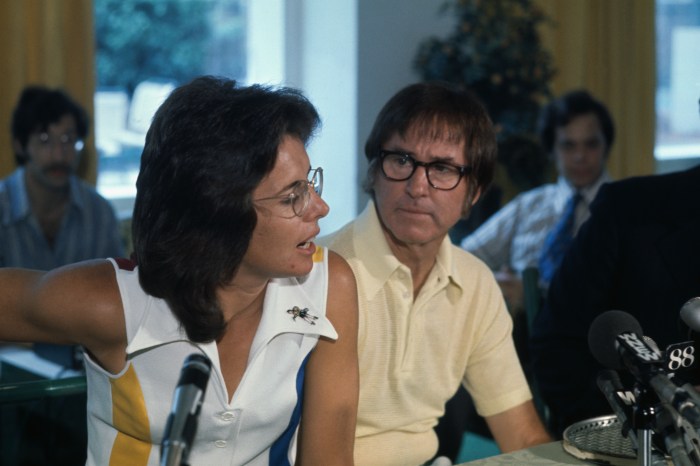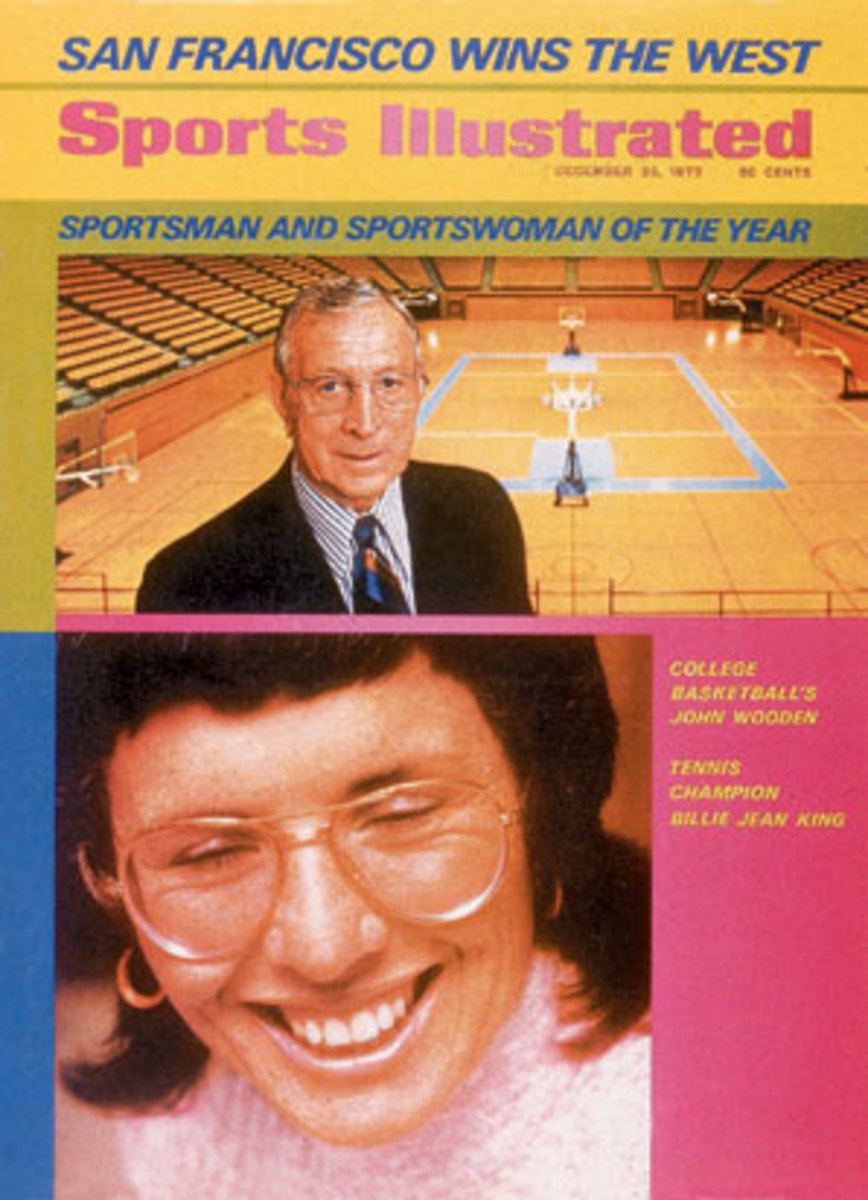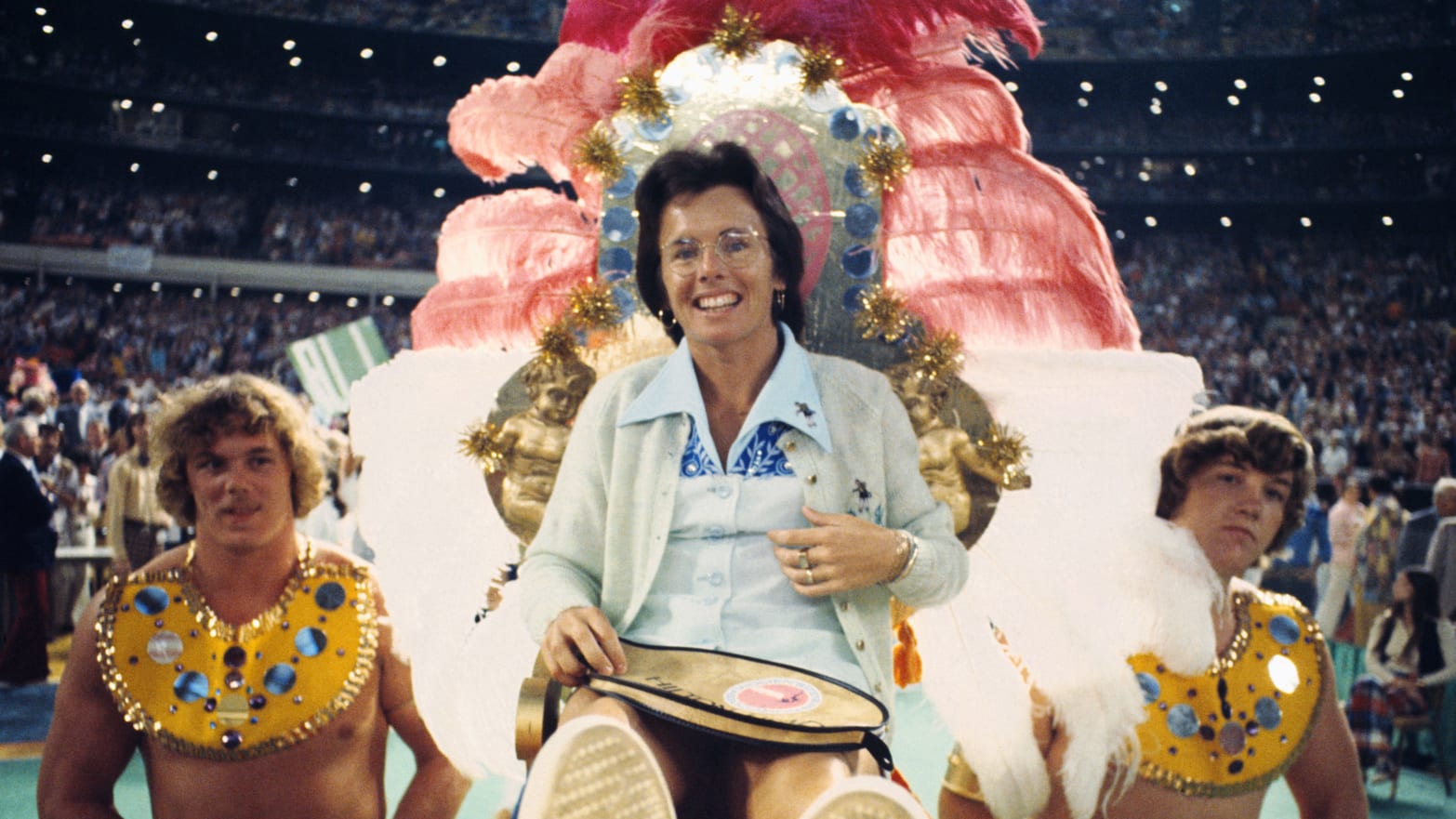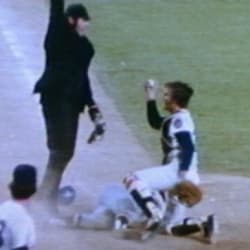September 20, 1973, 40 years ago: A made-for-TV spectacle is held at the Astrodome in Houston: A tennis match labeled "The Battle of the Sexes."
Bobby Riggs was a great tennis player once. The Los Angeles native wasn't big and strong, but he was quick, and relied on a speed game. He once won Wimbledon and the U.S. Open, and reached the Final of the French Open, all in the same year.
That year was 1939. In 1941, he won the U.S. Open again. After serving in the U.S. Navy during World War II, he won the U.S. Pro title in 1946, '47 and '49. (Professionals were barred from the "Grand Slam" tournaments -- Wimbledon and the U.S., French and Australian Opens -- until 1968.)
Bobby had to turn professional, because he was a compulsive gambler. He always needed money. He became known as a hustler, a man who would do anything for money, and, remarkably, could usually do it. Indeed, after what I'm about to talk about was all over, this was spoofed on an episode of the TV show The Odd Couple. He had a massive ego, but, like his contemporary Dizzy Dean and later baseball star Reggie Jackson, he could usually back it up.
As early as 1951, he challenged one of the top female tennis players, Pauline Betz -- an ex-girlfriend of his. She won the U.S. Open in 1942, 1943 and 1944, and both the U.S. Open and Wimbledon in 1946. They were on tour, and played each other in a series of matches, as the warmup act before a series of matches between pro stars Jack Cramer and Pancho Segura. In 1967, he was elected to the International Tennis Hall of Fame.
In 1973, he was 55 years old, well past the age where he could make money playing tennis -- or so it seemed. But the sport was as big as it has ever been. It was the high tide of feminism, and, in this sport as in few others, the women were stars as big as the men.
Whether he actually liked that, only he knew for sure. But he played the part of a proud male chauvinist pig. Bobby Riggs claimed that women's tennis was inferior, and that not even a top female player could beat him, not even at his age. Most tennis fans under the age of 40 said, "Who the hell is Bobby Riggs?"
He challenged the top female player of the time, Billie Jean King. In 1972, she had nearly won the Grand Slam: Winning Wimbledon, the U.S. Open and the French Open. (British player Virginia Wade won the Australian Open, beating Australian player Evonne Goolagong in the Final.) More than that, she was an advocate for making tennis tournaments give their female players prize money equal to male players. It wasn't happening quickly, but it was happening, one by one.
Sports Illustrated recognized that she had a social value on top of her competitive achievements, and made her the 1st female "Sportsman of the Year" -- but made her share the award with UCLA basketball coach John Wooden, the 1st time the award had been split.
Like Riggs, she was from Los Angeles -- or, more accurately, adjoining Long Beach, California. Like him, she was known for wearing horn-rim glasses. Unlike him, she did not look like the popular comedian Arte Johnson. But she did consider his challenge a joke, and rejected it.
So he challenged another major women's star, the Australian Margaret Court. They played each other on May 13 -- Mother's Day, and Court was then one of the few women to have returned to a star level in tennis after having children -- in the San Diego suburb of Ramona, California. He was 55, she was 30. It should have been a mismatch.
It was -- the other way. He got into her head, and won 6-2, 6-1. It was known as the Mother's Day Massacre. It got him on the cover of both Time and its sister publication Sports Illustrated, the latter carrying the headline, "NEVER BET AGAINST THIS MAN." And his insults to women's tennis, and to women in general, got bigger than ever. And male chauvinists loved it. (Shades of Donald Trump, but only nasty, not criminal in nature.)
Now, brimming with confidence, he challenged King again. Everyone told Billie Jean that she had to accept, for womankind, and for the sake of sportsmanship, because Bobby was a pig first, and a male chauvinist pig second.
The match would be held at the Astrodome in Houston, televised live on ABC -- meaning that it would be anchored by one of the few figures in sports more polarizing than Riggs: Howard Cosell. (Give Riggs credit for this: He had better hair than Cosell. Not better than too many others, but better than Cosell.) The prize was winner-take-all: $100,000. (About $525,000 in today's money.)
The opening ceremonies were a farce. No pair of boxers ever entered the ring like this. Professional wrestlers may have learned a thing or two from it. King entered first, carried in on a feather-adorned litter by four bare-chested bodybuilders, making her look like Cleopatra and them like her slaves. She had a look on her face suggesting, "I can't believe I agreed to this."
Did you think I was kidding?
Riggs was no less ridiculous: He came in seated in a rickshaw, drawn by busty models. He presented King with a giant lollipop -- a Sugar Daddy. She countered by giving him a piglet, pointing out that he was a "pig." The piglet was squealing, suggesting that at least one living thing less wanted to be in the Astrodome than she did. But she knew she had to do it.
Did Riggs really think he could win? One fact suggests that he didn't: Tootsie Roll, makers of the Sugar Daddy, gave him $50,000, half of what he stood to win upon winning the match, to wear a tracksuit jacket with the Sugar Daddy logo on it. He took it off midway through the 1st set.
Again, Bobby was 55. Billie Jean was 29. Still, knowing what he had done to Margaret Court, Las Vegas oddsmakers made him the favorite. Indeed, he jumped out to a 3-2 lead after breaking Billie Jean's serve in the 1st set.
But, now into the actual match and able to take things seriously, she came right back and broke his serve in the next game. He played his usual game (at this stage of his career), dropping lobs and making soft shots. She countered these effectively, and made him use his old legs. It was the tennis version of jujitsu: She turned his fighting style against him.
She won the 1st set, 6-4. She won the 2nd set, 6-3. Even today, women's tennis is best-2-out-of-3 sets, while the men's version is best-3-out-of-5. This was to be best-3-out-of-5, and that was another reason the oddsmakers favored Riggs: In spite of King's age advantage, they thought women couldn't handle 5 sets.
She didn't need to: She won the 3rd set, 6-3. After match point, Riggs, quite spry for 55, jumped over the net as if he'd won, and shook her hand.
Riggs' relevancy was over. King's was just beginning. By the time she was done, she had won 12 women's singles titles at majors: Wimbledon 6 times, in 1966, '67, '68, '72, '73 and '75; the U.S. Open 4 times, in 1967, '71, '72 and '74; the Australian Open in 1968; and the French Open in 1972. Throw in 16 women's doubles titles from 1961 to 1979 -- 18 years apart -- and 11 mixed doubles titles from 1967 to 1976, and that's a total of 39 majors. An average of 2 a year.
But beyond the victories: Along with Babe Ruth, Joe Louis, Jackie Robinson and Muhammad Ali, she is 1 of the 5 most important athletes of the 20th Century, because of how she raised the profile, and the prize money, of women's sports. And, with Ali's death in 2016, she's the only one of those still alive.
To put it into a baseball perspective: She had Hank Aaron's talent, Curt Flood's drive to make the sport more fair, and Andy Messersmith's success at that endeavor, and took as much heat for it as all 3.
In 1975, Seventeen magazine polled its readers, and they named Billie Jean their most admired woman. Then again, these were the days when The Weekly Reader polled grade school kids, and the biggest "hero" of both genders was O.J., ahead of Moon lander Neil Armstrong.
In 1975, Seventeen magazine polled its readers, and they named Billie Jean their most admired woman. Then again, these were the days when The Weekly Reader polled grade school kids, and the biggest "hero" of both genders was O.J., ahead of Moon lander Neil Armstrong.
The fact that she did all of this while staying in the closet until she no longer could, and then accepted her role as a gay rights icon as well as a feminist icon and a sports icon, makes her even more remarkable.
She is a member of the International Tennis Hall of Fame, and the National Tennis Center at New York's Flushing Meadow-Corona Park is named for her. (The main stadium is named for Arthur Ashe, but the entire complex is named for Billie Jean.) In 2009, Barack Obama awarded her the nation's highest civilian honor, the Presidential Medal of Freedom.
To put her work in perspective: The men's and women's winners from Wimbledon in 2013 got $2.2 million each.
Today, Billie Jean King is 69 years old, and still promoting tennis, and women's sports in general, wherever she can. She and Riggs actually became friends, and when he died in 1995, she spoke at his funeral.
In 2001, ABC aired a TV-movie, When Billie Beat Bobby, starring Holly Hunter and Ron Silver.
*
Also on September 20, 1973, the New York Mets beat the Pittsburgh Pirates, 4-3 at Shea Stadium, across Roosevelt Avenue from Flushing Meadow-Corona Park, where the U.S. Open would be moved from Forest Hills, also in Queens, in 1978.
Top: Shea Stadium (with its 1981-2008 seat-color scheme).
Middle: Roosevelt Avenue, the 7 Train on the Subway system,
and the Long Island Rail Road Port Washington Branch.
Bottom: Arthur Ashe Stadium and Louis Armstrong Stadium,
part of the Billie Jean King National Tennis Center.
This was "The Ball Off the Wall Game." There was a 5-way dogfight for the National League Eastern Division title. Going into the game, the Pirates were in 1st place, the Montreal Expos were 1 game back, the Mets and the St. Louis Cardinals both a game and a half back, and the Chicago Cubs 4 games back. Even so, the Pirates, winners of the 1971 World Series and the last 3 NL East titles, struggling all year after the death of Roberto Clemente in a plane crash the previous New Year's Eve, were the only team above .500, at 75-74. It seemed like no one wanted to win that Division.
But the Metropolitans and Buccos sure played this game like they both wanted to win it. The game's only home run was hit by Pirate (and future Met) Richie Hebner in the 7th inning, but the Mets tied it 2-2 in the 8th. Both teams scored in the 9th to make it 3-3 and send it to extra innings.
It went to the top of the 13th inning. With 1 out, Richie Zisk singled off Ray Sadecki. Manny Sanguillen flew to right for the 2nd out. Dave Augustine, a 23-year-old center fielder from West Virginia in only his 5th major league game, hit one deep to left. It looked like a home run.
Except it hit the top of the fence, and, instead of bouncing over for a homer, it bounced back, right into Cleon Jones' glove. That's a hit. But Jones pivoted, and fired to Wayne Garrett (playing shortstop instead of his usual 3rd base). Garrett saw that Zisk was trying to score, and threw home to catcher Ron Hodges. Zisk was out at the plate.
The bottom of the 13th began with walks drawn by John Milner and Ken Boswell. Don Hahn popped up to 1st base. But Hodges singled to left, scoring Milner with the winning run. The Mets went on to win the Division, by a game and a half over the Cardinals, 2 1/2 over the Pirates, 3 1/2 over the Expos and 5 over the Cubs. (Although he was on the Mets roster for this game, Willie Mays, soon to announce his retirement, did not play.)
The Mets ended up clinching the Division in Chicago against the Cubs on October 1, and beat the Cincinnati Reds for the Pennant at home on October 10. The Oakland Athletics would win the World Series, beating the Mets in Game 7 at the Oakland Coliseum on October 21.







No comments:
Post a Comment